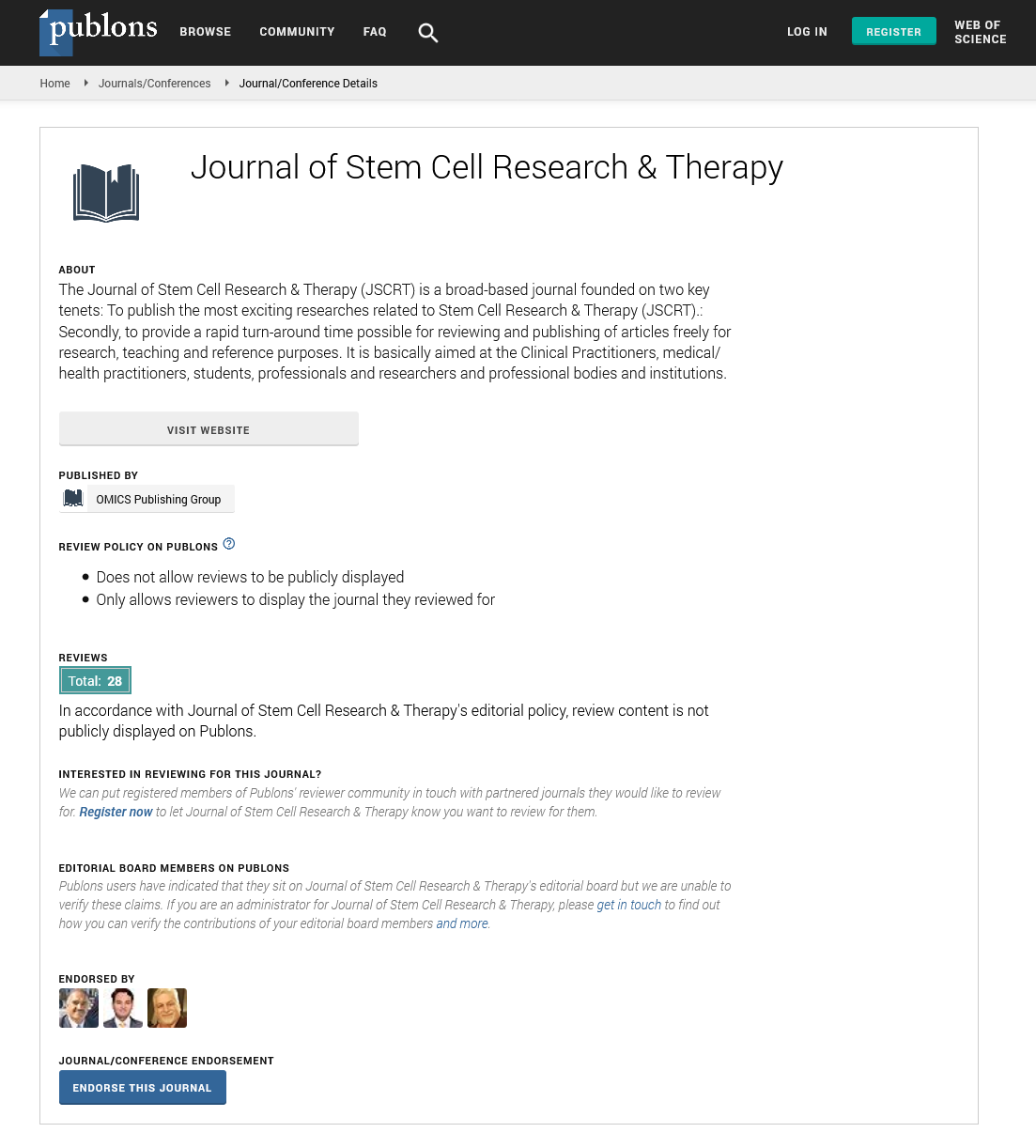Indexed In
- Open J Gate
- Genamics JournalSeek
- Academic Keys
- JournalTOCs
- China National Knowledge Infrastructure (CNKI)
- Ulrich's Periodicals Directory
- RefSeek
- Hamdard University
- EBSCO A-Z
- Directory of Abstract Indexing for Journals
- OCLC- WorldCat
- Publons
- Geneva Foundation for Medical Education and Research
- Euro Pub
- Google Scholar
Useful Links
Share This Page
Journal Flyer

Open Access Journals
- Agri and Aquaculture
- Biochemistry
- Bioinformatics & Systems Biology
- Business & Management
- Chemistry
- Clinical Sciences
- Engineering
- Food & Nutrition
- General Science
- Genetics & Molecular Biology
- Immunology & Microbiology
- Medical Sciences
- Neuroscience & Psychology
- Nursing & Health Care
- Pharmaceutical Sciences
Commentary - (2022) Volume 12, Issue 6
Stem Cell Banking for Regenerative Therapies
Beny Novak*Received: 30-May-2022, Manuscript No. JSCRT-22-17270; Editor assigned: 03-Jun-2022, Pre QC No. JSCRT-22-17270(PQ); Reviewed: 17-Jun-2022, QC No. JSCRT-22-17270; Revised: 24-Jun-2022, Manuscript No. JSCRT-22-17270(R); Published: 04-Jul-2022, DOI: 10.35248/2157-7633.22.12.537
Description
Stem cell banking, also known as preservation, is the process of extracting, processing, and storing stem cells so that they might be used for treatment in the future. Stem cells have the incredible ability to change into any tissue or organ in the body. They have the ability to treat over 80 designated life-threatening illnesses and bring countless benefits to the newborn, siblings, and family as a result of this unique characteristic.
Stem cells, particularly those obtained from umbilical cord blood, have remarkable regenerative capabilities and can treat more than 80 disorders. These stem cells have the ability to grow into blood cells, which can be used to replace damaged cells.
Cord blood banking has exploded in popularity in recent years due to its capacity to cure malignancies including lymphomas and leukaemia, as well as genetic abnormalities, metabolic and immunological problems. Umbilical Cord Blood Banking at the time of delivery is strongly recommended by doctors all over the world. This is the procedure for extracting valuable stem cells from the human body, processing them, and storing them for future use in stem cell therapies.
Low temperatures are used in stem cell banks to preserve biological characteristics and protect stem cells against contamination and degeneration. Any stem cell bank must follow standardised and quality-controlled preservation protocols in order to keep the cells viable for longer periods of time without losing their qualities. Preserving stem cells from the kid's umbilical cord blood at the time of birth ensures a healthy future for the entire family, not just the infant.
Stem cells are being used in modern medicine to treat over 80 different medical problems using replacement and repair techniques. Over 13 lakh stem cell transplants have been performed around the world in the last 50 years. Currently, more than 50,000 transplants are performed each year, and the number is rising. Because stem cells have the ability to self-renew and specialise into multiple cell types, they have been used to treat a variety of ailments.
In the following fields, stem cells have been effectively used and are being explored for future application. Every person has a 5% chance of being diagnosed with an illness that can be treated with stem cells. As a result, a family of eight individuals, including the child, siblings, parents, and grandparents, has a 40% chance of being diagnosed with a condition that necessitates the use of stem cells for treatment.
Conclusion
Adult stem cells (hematopoietic and mesenchymal) have shown enormous therapeutic promise in humans. Human embryonic stem cells are now utilised mostly to study development and disease progression, but they also have enormous therapeutic promise. For therapeutic and research purposes, the capacity to retain stem cells is crucial. Cell preservation allows for cell transfer between locations as well as the completion of safety and quality control testing. Preservation also allows for the establishment of a manufacturing paradigm for cell therapies, allowing for a greater number of products to be manufactured at a single facility.
Citation: Novak B (2022) Stem Cell Banking for Regenerative Therapies. J Stem Cell Res Ther. 12:537.
Copyright: © 2022 Novak B. This is an open-access article distributed under the terms of the Creative Commons Attribution License, which permits unrestricted use, distribution, and reproduction in any medium, provided the original author and source are credited.

